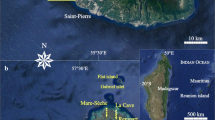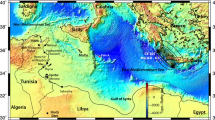Abstract
The southern Ryujyu islands mark an active convergent plate boundary. Large tsunamis in the area have transported huge boulders composed of Holocene fossil corals from fringing reefs along the islands. The boulders are suitable for dating with radiocarbon and provide evidence for inundation, run-up heights and timing of past tsunamis. Based on the ages of such tsunami boulders, we interpret that large tsunamis have occurred repeatedly with intervals of several hundred to one thousand years. Before the Meiwa tsunami of 1771, the area had been inundated by large tsunamis at about 600, 1000 and 2000y. B.P. The Okinawa-Sakishima tsunami of about 2000y.B.P. is interpreted to have been by far the largest of the sequence from huge tsunami boulders brought up around 20m higher than mean sea level.
Access this chapter
Tax calculation will be finalised at checkout
Purchases are for personal use only
Preview
Unable to display preview. Download preview PDF.
Similar content being viewed by others
References
Lida, K. (1958) Magnitude and Energy of Earthquakes accompanied by Tsunami and Tsunami Energy, Nagoya Univ. J. Earth. Sci., 6, 101–112.
Imamura, A. (1938) On the Earthquake Zone of the Ryukyus and Large Meiwa Tsunami, Jishin, 10, 431–450. (in Japanese)
Kato, Y. (1983) Age and Origin of So-called Tsunami-oishi, Ishigaki Island, Okinawa Prefecture, J. Geol. Soc. Japan, 89, 471–474. (in Japanese)
Makin, K. (1981) Meiwa Tsunami in Yaeyama,Jyono Press, 462pp. (in Japanese)
Ota, Y., Pirazzoli, P. A., Kawana, T. and Moriwaki, H. (1985) Late Holocene Coastal Morphology and Sea-level Records on Three Small Islands, the South Ryukyus, Japan, Geogr. Rev. Japan, 58B, 185–194.
Watanabe, H. (1985) Catalogue of Destructive Historical Tsunamis around Japan, Tokyo Univ. Press, 206 pp. (in Japanese)
Author information
Authors and Affiliations
Editor information
Editors and Affiliations
Rights and permissions
Copyright information
© 1995 Springer Science+Business Media Dordrecht
About this chapter
Cite this chapter
Nakata, T., Kawana, T. (1995). Historical and Prehistorical Large Tsunamis in the Southern Ryukyus, Japan. In: Tsuchiya, Y., Shuto, N. (eds) Tsunami: Progress in Prediction, Disaster Prevention and Warning. Advances in Natural and Technological Hazards Research, vol 4. Springer, Dordrecht. https://doi.org/10.1007/978-94-015-8565-1_15
Download citation
DOI: https://doi.org/10.1007/978-94-015-8565-1_15
Publisher Name: Springer, Dordrecht
Print ISBN: 978-90-481-4553-9
Online ISBN: 978-94-015-8565-1
eBook Packages: Springer Book Archive




